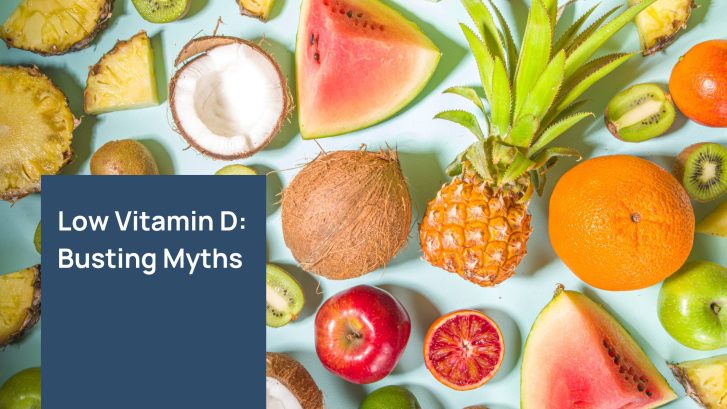Vitamin D, often referred to as the “sunshine vitamin,” plays a crucial role in maintaining our health. It supports bone health, boosts the immune system, and even affects mood and energy levels. Despite its importance, misconceptions about vitamin D deficiency abound. Many myths leave people confused about what vitamin D does, how to test for it, and how to address deficiencies.
Let’s set the record straight by busting the top five myths about vitamin D deficiency.
Myth 1: “I Get Enough Sun, So I Can’t Have Vitamin D Deficiency”
Sun exposure is a key source of vitamin D, but relying solely on sunlight doesn’t guarantee sufficient levels. Factors such as geographic location, skin type, and lifestyle choices play a significant role in how much vitamin D your body produces.
The Truth
- Geography Matters: In regions with long winters or limited sunlight, vitamin D production may be insufficient, even for those who spend time outdoors.
- Sunscreen Use: While sunscreen protects against harmful UV rays, it can also reduce the skin’s ability to produce vitamin D.
- Skin Tone: People with darker skin tones have more melanin, which reduces the skin’s ability to generate vitamin D from sunlight.
Even if you’re getting regular sun exposure, it’s still possible to have a deficiency. A vitamin D test is the best way to confirm your levels.
Myth 2: “Vitamin D Deficiency Only Affects Bones”
It’s true that vitamin D is essential for calcium absorption and bone health, but its impact extends far beyond your skeleton.
The Truth
Vitamin D deficiency can lead to a host of health issues, including:
- Weakened Immunity: Low levels are linked to increased susceptibility to infections, such as colds and flu.
- Mood Disorders: Studies have found connections between vitamin D deficiency and depression, anxiety, and seasonal affective disorder (SAD).
- Chronic Conditions: Deficiency has been associated with an increased risk of diabetes, cardiovascular disease, and certain cancers.
While bones often steal the spotlight when it comes to vitamin D, it’s important to recognise its role in overall health.
Myth 3: “A Healthy Diet Provides All the Vitamin D I Need”
A balanced diet is vital for good health, but vitamin D is one nutrient that can’t easily be obtained from food alone.
The Truth
- Limited Dietary Sources: Few foods naturally contain vitamin D. Fatty fish like salmon, mackerel, and tuna are among the best sources, along with fortified products such as milk and cereals.
- Insufficient Intake: Even with a diet rich in these foods, it’s challenging to meet the daily recommended intake through food alone. For example, a serving of salmon provides about 400 IU of vitamin D, but adults often need 600-800 IU daily—and even more for those with deficiencies.
Dietary vitamin D is an important supplement to sun exposure, but it’s unlikely to cover all your needs without additional support.
Myth 4: “If I Don’t Feel Symptoms, My Vitamin D Levels Must Be Fine”
Many people assume that no symptoms mean no deficiency, but this couldn’t be further from the truth.
The Truth
Vitamin D deficiency is often referred to as a “silent condition” because it doesn’t always present obvious symptoms—especially in the early stages. When symptoms do appear, they can be vague and mistaken for other issues, including:
- General fatigue
- Muscle weakness or aches
- Frequent illnesses
- Subtle mood changes
Because vitamin D deficiency can silently contribute to long-term health problems, it’s essential to monitor levels with a vitamin D test, even if you feel fine.
Myth 5: “Taking More Vitamin D Is Always Better”
If a little vitamin D is good, more must be better—right? Not so fast. Overloading on vitamin D can be harmful.
The Truth
Vitamin D is fat-soluble, meaning it’s stored in the body’s fat tissues and liver. Taking too much can lead to toxicity, with symptoms such as:
- Nausea and vomiting
- Kidney damage due to excess calcium buildup
- Weakness and confusion
For most people, excessive vitamin D is unlikely when relying on sunlight and food sources. However, high-dose supplements should only be taken under medical supervision. The best approach is to use a vitamin D test to tailor supplementation to your specific needs.

How to Test for Vitamin D Deficiency
You can determine your vitamin D levels through an at-home Vitamin D Rapid Test. It’s a rapid test for the semi-quantitative detection of 25-hydroxy vitamin D (25 (OH) D) in human fingerstick whole blood. This test measures the amount of vitamin D in your bloodstream and helps guide treatment if levels are low.
What Are Healthy Vitamin D Levels?
- Deficiency: Less than 10 ng/mL
- Insufficiency: 10-20 ng/mL
- Optimal: 30-100 ng/mL
- Toxicity: Above 100 ng/mL
Testing is particularly important for those at higher risk, including individuals who:
- Live in areas with limited sunlight
- Have darker skin tones
- Are pregnant or breastfeeding
- Are older adults
- Have conditions affecting nutrient absorption
Preventing and Treating Vitamin D Deficiency
1. Get Regular Sun Exposure
Aim for 10-30 minutes of sunlight on your skin a few times a week, depending on your skin tone and location. Avoid peak hours to reduce the risk of sunburn.
2. Eat Vitamin D-Rich Foods
Include foods like salmon, egg yolks, fortified dairy products, and mushrooms in your diet.
3. Consider Supplements
For those unable to get enough vitamin D from sun exposure or diet, supplements can be a convenient option. Look for recommendations from your healthcare provider based on your vitamin D test results.
4. Address Underlying Conditions
If absorption issues or medical conditions are contributing to deficiency, work with your doctor to manage them effectively.
Debunking Myths for Better Health
Understanding the facts about vitamin D deficiency empowers you to take proactive steps toward maintaining your health. Whether it’s ensuring you get enough sunlight, eating a nutrient-rich diet, or taking supplements, the key is balance.
If you’re unsure about your vitamin D levels, don’t rely on guesswork—get a vitamin D test to know for sure. By busting these myths and staying informed, you can protect your body, mind, and overall well-being.
Remember, knowledge is your best defence against misinformation. Share this blog to help others separate fact from fiction about vitamin D deficiency!

